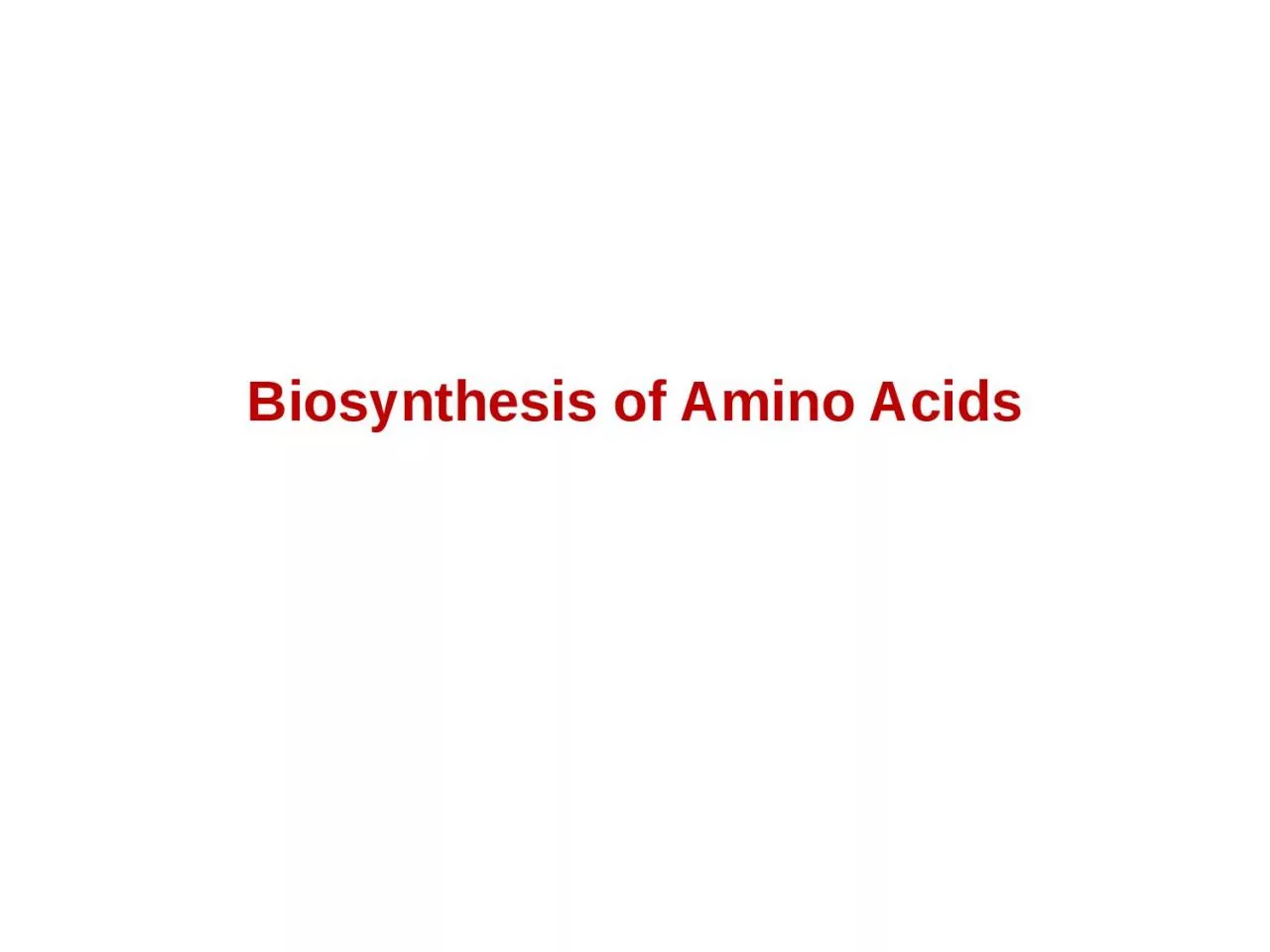

Metabolic relationship of Amino Acids Biosynthesis of Amino Acids The carbon skeletons of many amino acids may be derived from metabolites in central pathways allowing the biosynthesis of some but not all the amino acids in humans ID: 1034794
Download Presentation The PPT/PDF document "Biosynthesis of Amino Acids" is the property of its rightful owner. Permission is granted to download and print the materials on this web site for personal, non-commercial use only, and to display it on your personal computer provided you do not modify the materials and that you retain all copyright notices contained in the materials. By downloading content from our website, you accept the terms of this agreement.
1. Biosynthesis of Amino Acids
2.
3. Metabolic relationship of Amino Acids
4. Biosynthesis of Amino AcidsThe carbon skeletons of many amino acids may be derived from metabolites in central pathways, allowing the biosynthesis of some, but not all, the amino acids in humans. Amino acids that can be synthesized in this way are therefore not required in the diet (nonessential amino acids)
5. The amino acids having carbon skeletons that cannot be derived from normal human metabolism must be supplied in the diet (essential amino acids)For the biosynthesis of non-essential amino acids, amino groups must be added to the appropriate carbon skeletons This generally occurs through the transamination of an α-keto acid corresponding to that specific amino acid.
6. Based on the principles of nutritional biochemistry, it was estimated that human require ten of the twenty amino acids in their diet in order to thrive. The ten amino acids are called essential amino acids whereas, the other ten amino acids which humans can synthesize on their own, are called non-essential amino acids
7.
8. Overview of Amino Acid BiosynthesisThe carbon skeletons of all twenty amino acids are derived from just seven metabolic intermediates, that together, are found in three metabolic pathways. These include:Three glycolytic pathway intermediates3-phosphoglycerate3-phosphoenolpyruvate puruvate
9. Two pentose phosphate pathway intermediatesRibose 5- phosphate erythrose 4-phosphateTwo citrate cycle intermediatesα-ketoglutarate and oxaloacetate
10. Non-EssentialTransamination of α-ketoacids that are available as common intermediatesAll except tyrosine are derived from one of the following common intermediates: PyruvateOxaloacetateα-ketogenic3-phosphoglycerateEssentialTheir α-ketoacids are not common intermediates (Enzymes needed to form them are lacking)
11. Amino Acid Biosynthetic families, grouped by metabolic precursors
12. The amino acids that are precursorsfor other amino acids are shown in yellow. The nine essential amino acids are shown in boldface.
13.
14.
15. Biosynthesis of AspartateAspartate can be synthesized by the body, so it is classified as a non-essential amino acid. In human, aspartate is most frequently synthesized through the transamination of oxaloacetate. Transamination, a chemical reaction that transfers an amino group to a ketoacid to form new amino acids.
16. The biosynthesis of aspartate is facilitated by an aminotransferase enzyme: the transfer of an amine group glutamine yields aspartate and an alpha-keto acidAspartate is also a by product of the urea cycle.
17.
18. Biosynthesis of Pyruvate
19. Aromatic amino acidsAromatic amino acids are amino acids that include an aromatic ring. Among 20 standard amino acids:PhenylalanineTryptophanTyrosineHistidineAromatic amino acids are able to absorb light due to their conjugated double bonds. This characteristic of aromatic amino acids is used to quantify the concentration of proteins in an unknown sample.
20. Phenylalanine, tryptophan, and histidine are essential amino acids for animals. Since they are not synthesized in the human body, they must be derived from the diet. Tyrosine is semi-essential; it can be synthesized, but only from phenylalanine. A lack of the enzyme phenylalanine hydroxylase, used in tyrosine synthesis, causes phenylketonuria and concurrently renders tyrosine an essential amino acid.
21. Synthesis of the aromatic amino acids begins with the synthesis of chorismate - an important intermediate for many biosynthetic pathways. Phosphoenol pyruvate and erythrose 4-phosphate serve as beginning substrates for the pathway. A price of one NADPH + H+ and one ATP is exacted for every chorismate formed. In the sixth step of the synthesis another phosphoenol pyruvate molecule is added to the growing moleculeBiosynthesis of Aromatic amino acids
22.
23. Biosynthesis of TryptophanTryptophan synthesis is complex and involves 5 steps from chorismate. Glutamate donates an amine group in the first step of the pathway and pyruvate is lost from chorismate. In the next threes steps a ribose sugar is added, this eventually contributes to the 5 membered ring of tryptophan. Energy is contributed to the process in the form of hydrolysis of pyrophosphate. This hydrolysis helps drive the addition of the ribose sugar in the second step of the reaction. In the last step of the pathway serine serves as the donor of the a carbon amino group of tryptophan.
24.
25.
26. Biosynthesis of Phenylalanine and TyrosinePhenylalanineChorismate is converted to phenylpyruvate in two steps and phenylalanine is synthesized by a transamination reaction with glutamate. No energy is require to run these reactions
27. TyrosineThe synthesis of tyrosine is very similar to the synthesis of phenylalanine, but the reactions are carried out by different enzymes under different regulatory control. NADH is created in the formation of 4-hydroxyphenylpyruvate. Tyrosine is made by a similar transamination reaction as that seen in phenylalanine synthesis.
28.
29.
30. Biosynthesis of HistidineThe synthesis of histidine is long and complex and its pathway is intertwined with nucleic acid biosynthesis (specifically purine). The pathway seems to be universal in all organisms able to synthesize histidine. The first five steps of the pathway take ribose from phosphoribosyl pyrophosphate (PRPP) and transform it into Imadiazole glycerol phosphate. Once the imadiazole ring is formed, glutamate donates the a-amino group and the newly formed amine is oxidized to histidine in the last step of the pathway. Energy is required in the form of ATP and pyrophosphate which is lost from phosphoribosyl pyrophosphate and ATP help drive the reaction.
31.